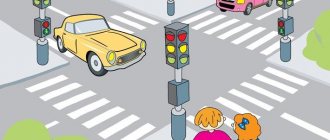Consultation for kindergarten parents on traffic rules
Consultation for parents “The road safety of your child depends on you”
The speed of movement and the density of traffic flows on the streets and roads of our country are rapidly increasing, and will continue to progress in the future.
Of particular importance in solving this problem is the early and correct preparation of our youngest pedestrians - children, who are already facing serious difficulties and dangers outside the gates of their homes, and who will have to live with an incomparably greater intensity of automobile traffic. Unfortunately, many parents have the misconception that their child should be taught safe behavior on the streets closer to the time when he goes to kindergarten or school. But it’s dangerous to think like that! After all, children develop a whole set of habits (unbeknownst to him and to us) from early childhood. Including demeanor. Therefore, the safety of a preschooler largely depends on what knowledge his parents instill in his head in early childhood. Children under the age of five do not realize the full danger of the world around them, cannot think ahead, and live only in the present, without thinking about the consequences that one or another of their actions may lead to. At this age, it is very important to ensure the safety of the preschooler and put into his head the knowledge that he should analyze his actions a little and think about the consequences. The best way to save your life and the life of your child on the roads is to follow the traffic rules! The question may arise: why explain to children the peculiarities of traffic, the rules of crossing the street, if children cross the road only holding the hand of an adult? Perhaps we shouldn’t bother them with these rules while they still don’t walk the streets on their own or use public transport? But we must always remember that the formation of conscious behavior is a long process. Today a child walks everywhere hand in hand with his mother, and tomorrow he will become an independent pedestrian and passenger of city transport. Work on teaching children the rules of competent and safe behavior on city streets and in public transport must be systematic. In order for it to bring the necessary results, one lesson or conversation with children is not enough. And one more important requirement: children do not have enough theoretical knowledge, they must apply it in practice. It is important that parents set an example for their children in following traffic rules. Take your time, cross the road at a measured pace. When going out onto the road, stop talking - the child must get used to the fact that when crossing the road you need to concentrate. Do not cross the road when the traffic light is red or yellow. Cross the road only in places marked with a “Pedestrian Crossing” road sign . Get off the bus, trolleybus, tram, taxi first. Otherwise, the child may fall or run onto the road. Invite your child to participate in your observations of the situation on the road: show him those cars that are preparing to turn, driving at high speed, etc. Do not leave with your child from behind a car or bushes without first inspecting the roads - this is a typical mistake, and children should not be allowed to repeat it. Do not allow children to play near roads or on the roadway. It is enough to have a conversation-game with your child on the rules of the road at least once a week for 10-15 minutes so that he looks at the situation with different eyes. Such a child will later be able to navigate independently in difficult situations on city highways. At the height of the summer holidays, many children go on vacation outside the city and find themselves in a completely different, unusual environment for them. And if the child is well versed in the rules of the road, parents can be calm about him. A common mistake made in such cases is the wrong approach to starting a conversation. Talking to children about the dangers of the road in an overly stern tone is ineffective. In this case, the child will not be interested in the conversation and, as a result, will learn only a small part of the information. It is much more effective to talk to your child calmly, choosing a moment when he is not busy with anything and his attention is at your disposal. Before explaining, indicate the importance and seriousness of the conversation, let the baby feel his importance. His attention near the road should be a request, not a demand. He must understand that they are worried about him and that he is in danger. This motivation is much stronger than fears of punishment or reproaches. To prevent your child from getting into trouble, teach him respect for the rules of the road patiently, daily, unobtrusively. The child should only play in the yard under your supervision. He must know: you can’t go out on the road. Do not intimidate the child, but watch with him and take advantage of the situation on the road, yard, street; Explain what happens to transport and pedestrians.
Develop your child’s visual memory and attention, and to do this, create various play situations at home. You are a model of behavior for children, you are an object of love and imitation for a child. This must always be remembered, and even more so when you take a step onto the roadway with your baby.
We recommend watching:
Consultation for parents in kindergarten. Road safety Consultation for parents. Dangerous intersections Consultation for parents “Teaching preschoolers traffic rules in the family” Children’s safety on the road. Consultation for parents of preschool children
Similar articles:
Consultation for parents on traffic rules. Children's safety is the concern of adults
Parents are the main teachers of safe behavior on the road for their children
With the start of a new school year, parents face new challenges. For some, children are returning to school, having managed to wean themselves from heavy traffic over the summer, while for others, the child will go “to first grade for the first time,” which means he will have to get used to a new life - and a new road. Perhaps you can even overcome it yourself, without the help of adults - in any case, you will have to learn this someday. One way or another, the student gradually turns into an independent road user. What should parents do to raise their child to be a law-abiding pedestrian? How to instill in him stable skills of safe behavior on the road from the first steps of school?
The most important thing that every parent should remember: the main teacher of safe behavior on the road for his child will not be the school, but he.
School can only reinforce the skills and sustainable road safety habits that you develop in your family. So far, unfortunately, teachers are forced to retrain schoolchildren or wean them from incorrect knowledge and bad habits instilled by adults. After all, if parents consider it possible to break traffic rules, then their children will behave in the same way. They just repeat everything mom and dad do.
The main thing for parents in instilling in a child the skills of safe behavior on the road should be the principle
“ Do as I do .”
In order for a child not to violate traffic rules, he must not only know them - he must get into the habit of observing them. Even if you are late, still cross the road only where it is allowed; fasten your seat belts, do not exceed the speed limit - in a word, do not violate the traffic rules. Your example will be much more clear than the words “don’t run a red light” repeated hundreds of times.
You need to remember it yourself and instill it in your child: traffic begins not from the roadway, but from the first steps from the threshold or entrance of the house.
Walk with your child all the way to school and unobtrusively point out the most dangerous areas - an uncontrolled intersection, a narrow sidewalk, a truck approach to a store, parked cars, etc. Be sure to pay attention to the dangers that arise when boarding and disembarking from public transport. Under no circumstances should you bypass a stationary bus or trolleybus. You need to wait until the vehicle leaves and only then cross the road at the pedestrian crossing.
At the same time, there is no need to instill in children an excessive sense of fear of traffic and moving cars.
Let the child associate everything connected with school, including the road, with brightness and kindness. At the same time, you need to teach him to be attentive, and this is not an easy thing. The processes of perception, attention and reaction in a child and an adult are completely different. Experienced drivers know, for example, that sounding the horn when they see a child running across the road is dangerous. The child may act unpredictably - instead of stopping, he may rush without looking back under the wheels of another car.
Even those children who know the rules of safe behavior on the road sometimes break them. Don't take the trouble to help the children. You may have to stop a child who doesn't want to wait for a traffic light. Or help a schoolchild cross the road. Do it kindly!
Tips and advice for parents on teaching children traffic rules
Inna Kuskova
Tips and advice for parents on teaching children traffic rules
General recommendations.
Exit from the entrance of the house.
-If it is likely that vehicles are moving at the entrance to the house, immediately draw the child’s attention and look together to see if there are any cars.
-If there is a car parked at the entrance or a tree growing that blocks the view,
stop and “look” to see if there is a hidden danger behind the obstacle.
Driving on the sidewalk.
- From time to time, draw your child’s attention to cars appearing in the distance and passing by, especially those that are traveling at high speed. Teach your child to notice vehicles from afar, follow them with their eyes and judge their speed.
-Stop at a parked vehicle and draw the child’s attention to how it blocks the view of the street. It is possible to think that there is no danger and go out onto the roadway, and at that time another car pulls out from behind a standing car.
-As a result of such observation, children develop the reflex of anticipating hidden danger, which is most important for safety on the street.
Crossing a roadway where there is no traffic light.
*When walking and along the roadway to kindergarten, school and back, teach your child to stop when approaching the roadway. Stopping will allow him to switch gears and assess the situation. This is the key rule of the passerby.
* At an intersection, teach children to notice vehicles preparing to turn right (first of all) and left. As a rule, vehicles turning right are in the extreme right position and turn on the right turn signal, while vehicles turning left are in the extreme left position and turn on the left turn signal.
*When watching large vehicles passing through the crossing, draw the child’s attention to the fact that while this car has not moved far, it may be hiding another that is driving behind it. Therefore, it is better to wait until the large vehicle moves further away.
Memorizing the route to kindergarten, school and home
*While driving down the street, show your child road signs and explain their name and purpose. Show all types of pedestrian crossings. Pay attention to the traffic lights, explain the meaning of each of them. Show the presence of shops, pharmacies, public transport stops, and street names.
*Draw together with your child the route to kindergarten or school. Show us the most dangerous sections of this route. Draw the safest path along this route. Then walk along the drawn route several times, both on the diagram and on the street.
MAGAZINE Preschooler.RF
Consultation for parents “Parents about road safety”Children, due to their age, are not always able to correctly assess the road situation and recognize danger. Do everything necessary to prevent danger from coming to your family. Timely teaching children the ability to navigate traffic situations, cultivate the need to be disciplined on the street, careful and prudent!
Remember, if you break the Rules, your child will do the same!
Teach your children the rules for safely crossing the road!
Discuss together the safest routes to travel, remind your child every day: BEFORE CROSSING THE ROAD, MAKE SURE IT IS SAFE!
Explain to your child that stopping the car right away is impossible! Learn to anticipate hidden dangers!
Discuss the safest routes together!
It is important for the child to remember that even a familiar, familiar road can be dangerous.
Dedicate a separate walk to the rules of crossing the road, check whether your child understands them correctly and knows how to use this knowledge in real traffic situations. To do this, practice crossing a pedestrian crossing together, across a one-way roadway, through controlled and uncontrolled intersections.
Walk with your child along the usual route to and from school. Talk about why it is important to walk the same path. Draw your child’s attention to all the dangers and hidden “traps” that may lie in wait for him along the way, think over the route so that it becomes safer.
Make sure that the child always has some extra time, but if the child is still late somewhere, explain to him that rushing on the road is not acceptable, and it is better to be late, but remain alive and healthy.
If you are driving a car: be sure to use a special restraint system and seat belts, buckle up yourself and make sure that the passengers in the car are buckled up. About 30% of children injured in road accidents are passengers.
During the holidays, it doesn’t matter whether your child stays in the city or leaves. It is necessary to use every opportunity to remind him of the rules of the road. Do not allow children to play near the roadway; there are closed playgrounds, stadiums, and gyms for games.
A stationary car is dangerous: it can block your view and make it difficult to notice the danger in time. You cannot go out onto the road because of parked cars. As a last resort, you need to carefully look out from behind a standing car, make sure that there is no danger, and only then cross the road.
Do not go around a stationary bus, either in front or behind!
From the stop you need to move towards the nearest pedestrian crossing. And after making sure of your safety, cross the road at a pedestrian crossing.
A slow moving car can hide behind a car going at high speed. A child often does not suspect that another car may be hidden behind one car.
It is not enough to teach children how to navigate when a traffic light is green; before you take a step onto the road, you need to make sure that cars are stopping or allowing you to pass.
On a street where cars rarely appear, children run out onto the road without first checking it and get hit by a car. Develop in your child the habit of always stopping before going out onto the road, looking around, listening, and only then crossing the street.
If you had to stop in the middle of the road, you need to be extremely careful, remember that cars are moving behind you. You cannot make a single movement without making sure it is safe.
Being next to an adult, the child relies on him and either does not watch the road at all or does not watch well. An adult does not take this into account. On the street, children are distracted by all sorts of objects and sounds, not noticing a moving car, and thinking that the way is clear, they break away from the hands of an adult and run across the road. Before crossing the road, hold your child's hand tightly.
In large cities, places of increased danger are arches and exit points from courtyards. Do not allow a child to run past a yard exit or arch ahead of an adult.
Teach children to follow traffic rules from an early age. And don’t forget that personal example is the most intelligible form of learning.
REMEMBER! The child learns the laws of the street, following the example of you, parents, and other adults. Let your example teach disciplined behavior on the street not only to your child, but also to other children.
Recommendations for parents
1. When driving on the sidewalk:
- keep to the right side of the sidewalk
- do not lead the child along the edge of the sidewalk: the adult must be on the side of the roadway
2. When preparing to cross the road:
- stop or slow down, look at the roadway
- involve your child in observing the situation on the road
- emphasize your movements: turning your head to look around the street, stopping to look around the road, stopping to let cars pass
- teach your child to recognize approaching vehicles
- do not stand with your child on the edge of the sidewalk, as when passing the vehicle can get caught, knocked down, or run over with its rear wheels
— repeatedly show your child how the vehicle stops at the crossing, how it moves by inertia.
3. When leaving home:
- immediately draw your child’s attention to the movement of vehicles at the entrance and together look to see if a car, motorcycle, moped, or bicycle is approaching you
— if there are vehicles at the entrance or trees growing that block your view, stop your movement and look around to see if there is any danger behind the obstacle.
4. When waiting for public transport:
- stand with children only on landing platforms, and if there are none, on the sidewalk or curb.
5. When crossing the roadway:
- cross the road only at pedestrian crossings or at intersections along the marked zebra line, otherwise the child will get used to crossing wherever he has to
- do not rush and do not run; always cross the road at a measured pace
- do not cross the road diagonally; Emphasize, show and tell your child every time that you are walking strictly across the street, that this is being done for better observation of cars and motor vehicles
- do not rush to cross the road if you see friends, relatives, or acquaintances on the other side. Don’t rush and don’t run towards them; instill in your child that this is dangerous.
- Don't start crossing a street where traffic rarely passes without looking around.
- Explain to your child that cars can unexpectedly leave the alley or the yard of the house
6. When boarding and disembarking from public transport:
- go out in front of the child, as the baby may fall, and an older child may run out of the parked vehicle onto the roadway
- approach the vehicle door only after a complete stop: a child, like an adult, can trip and get run over
- do not board public transport at the last moment when it departs; The front door is especially dangerous, as you can get under the wheels of a vehicle
— teach your child to be careful in the bus stop area, a particularly dangerous place for him: a stopped bus reduces the view of the road in this area.
7. When the car is moving:
- teach children to sit in the car only in the back seat; do not allow sitting next to the driver unless the front seat is equipped with a child seat
- Do not allow a small child to stand in the back seat while driving: in the event of a collision or sudden stop, he may fly over the back of the seat and hit the front window
- Do not allow children to be in the vehicle unattended.
Reminder for parents: Safe steps towards road safety.
What should parents know about their child?
At 3-4 years old, a child can distinguish a moving car from a stationary one, but he is sure that the car stops instantly.
At 6 years old - with peripheral vision he sees approximately 2/3 of what adults see; cannot determine what is moving faster: a bicycle or a sports car; does not know how to correctly distribute attention and separate the essential from the insignificant.
At 7 years old, you can more confidently distinguish the right side of the road from the left.
At 8 years old - can instantly respond to feedback, etc.; has experience of walking on the road; actively masters basic cycling skills; can determine the source of noise; establish a connection between the size of an object, its distance and time (the closer the car, the larger it is).
Educator: Amelchenko V.A.
| Next > |









